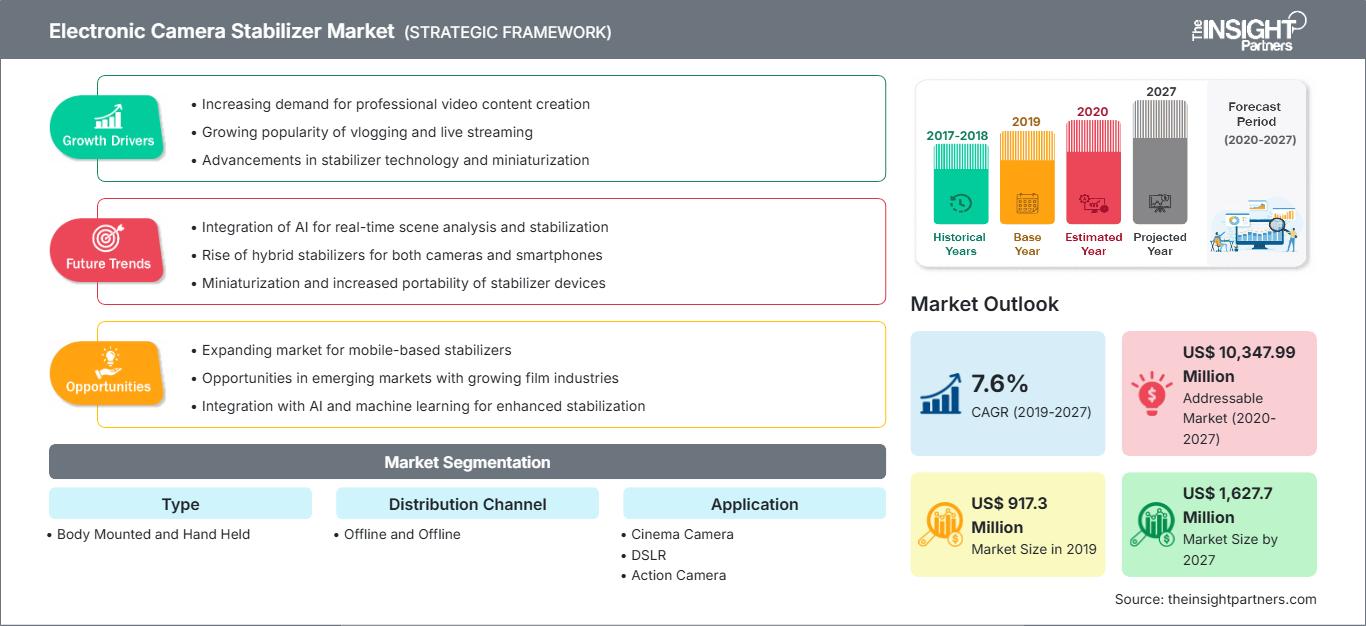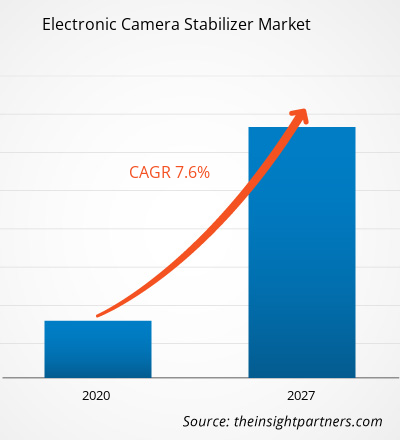The Electronic Camera Stabilizer Market was valued at US$ 917.3 million in 2019 and is projected to reach US$ 1,627.7 million by 2027; it is expected to grow at a CAGR of 7.6% from 2019 to 2027.
A camera stabilizer is an accessory that reduces motion blur in order to capture sharp photographs and videos. Professional photographers initially used camera stabilizers in the media & broadcast industry; however, they have now gained popularity among small movie makers and online content creators. Over the past few decades, the global entertainment and media sector has experienced significant growth, which can be attributed to the increased production of different genres of video content on both TV and big screen. Rapid technological changes, consumer behaviour, and business models have changed the way consumers want to experience and pay for entertainment and the media. The leaders in this industry also concentrate on building fan-focused businesses and brands to actively produce outstanding content. As a result, they spend/invest on technologies and equipment such as computer generated image (CGI) and visual effects (VFX), as well as a variety of different cameras and peripherals, including camera stabilizers.
Additionally, the amount of online content has been increasing over the past few years. This is due to the increased penetration of the Internet and the impact of social media on consumers. The increase in the average surfing time among today's population has made platforms such as YouTube and Instagram profitable, and this has attracted a lot of competition among content creators. To stay ahead in the competition, content creators have started investing heavily in cameras and peripherals, such as camera stabilizers, to deliver high quality videos. This increasing investment has driven cameras and camera peripherals sales and indirectly influenced camera stabilizer growth in the global market. Nevertheless, the use of camera and camera peripherals is not limited to the entertainment and media sector, camera stabilizers are being profoundly used in the event industry owing to the increased affordability of cameras and their accessories, and growing consumer expectations for video quality. People today are spending heavily on capturing wedding ceremonies with high-quality video recordings. Therefore, market players in the event management industry have started investing in high-quality camera equipment to bridge the demand. This is, in turn, driving the growth of the global camera stabilizer market.
North America led the electronic camera stabilizers market with the most significant market share in the world, followed by Europe and APAC. The growing adoption of consumer electronics such as camcorders, digital cameras, and smartphones, and increased spending capability of customers are anticipated to drive the demand for camera stabilizers in the region during the forecast period.
The global electronic camera stabilizer market is segmented into type, application, and distribution channel. Based on type, the market is further segmented into body mounted and handheld. Based on application, the market is further bifurcated into cinema camera, DSLR, action camera, and smartphones. Based on distribution channel, the market is further categorized into offline and online. Camera stabilizers are designed to provide stability while recording a video of a moving object. Significant growth of associated industries such as film and entertainment, sports, professional photography, underwater travel, and sports drive the demand for camera stabilizers. The product's primary end users include both professional and amateur videographers. The focus of manufacturers is to integrate advanced technologies and develop new designs to accommodate compact and heavy-duty cameras. Camera stabilizers are one of the essential types of equipment used while making movies, music videos, documentaries, and various other forms of entertainment. Continuous developments, such as high penetration of 4K, 6K, and 8K, in film and web series production within the media and entertainment industry is also expected to increase the demand for advanced cameras and stabilizers. One of the significant factors that will have a positive impact on the global camera stabilizers market in the coming years will be the increasing use of camera stabilizers for action photography. The growing popularity of the film industry has led to an increase in the levels of creativity in cinematography. Professionals are increasingly trying out imaginative shots involving perfect motion, and they use specialized lenses to capture creative shots. Professional photographers use specific equipment such as rigs and camera stabilizers to get perfect shots to achieve the artistic side. Therefore, the rising demand for action photography is propelling the use of camera stabilizers.
Customize This Report To Suit Your Requirement
You will get customization on any report - free of charge - including parts of this report, or country-level analysis, Excel Data pack, as well as avail great offers and discounts for start-ups & universities
Electronic Camera Stabilizer Market: Strategic Insights

-
Get Top Key Market Trends of this report.This FREE sample will include data analysis, ranging from market trends to estimates and forecasts.
Market Insights
Surge in Growth of Entertainment Industry
The film industry is seen as one of the largest and most lucrative categories in the global entertainment industry. The sector produces several films annually, with Hollywood being the world's largest contributor to the film industry. China's film industry is one of the world's largest film industries, churning out revenues in 2016 of about US$ 6.6 billion. It is expected that this promising outlook of the film and entertainment industry will drive demand for electronic camera stabilizers to achieve perfect shots and videos. The market growth can be attributed to the increased production of different genres of video content on both TV and big screen. Rapid technological changes, consumer behavior, and business models have changed the way consumers want to experience and pay for entertainment and the media. The leaders in this industry also concentrate on building fan-focused businesses and brands to actively produce outstanding content. As a result, they spend/invest on technologies and equipment such as computer generated image (CGI) and visual effects (VFX), as well as a variety of different cameras and peripherals, including camera stabilizers.
Type-Based Market Insights
Based on type, the electronic camera stabilizer market is segmented into: Body Mounted and Hand Held. The handheld segment led the market by type in 2019 for the electronic camera stabilizers. Advantages such as the lightweight, easy to carry, and increased use for filmmaking and action sports shooting will contribute to the growth of the handheld camera stabilizers market in the coming years.
Distribution Channel Based- Market Insights
Based on Distribution Channel, the electronic camera stabilizer market is segmented into: Offline, Online. Offline sales channel offers its customers face-to-face camera stabilizers in an office or store owned or rented by the business. Brick-and - mortar stores have found it hard to compete with most web-based companies such as Amazon.com Inc. The offline channel leads in terms of market share by sales channel; however, the online channel segment is expected to acquire a high market share through the forecast period.
Application Based- Market Insights
Based on application, the electronic camera stabilizer market is segmented into: Cinema Camera, DSLR, Action Camera, and Smartphones. The DSLR segment led the market by application for electronic camera stabilizers. The section comprises Mirrorless cameras and DSLR cameras. Camera stabilizers help capture long-tracking shots and make the zooms and pan elaborate. They give them a more professional look to the shots captured using digital single-lens reflex (DSLRs). Some of the camera stabilizers based on weight have sufficient weight capacity to carry DSLR cameras.
Product development is the commonly adopted strategy by companies to expand their product portfolio. SZ DJI Technology Co., Ltd., Ikan Corporation, edelkrone, Gudsen Technology Co., Ltd. (Moza), and Zhiyun, among others are the key players implementing strategies to enlarge the customer base and gain significant share in the global Electronic Camera Stabilizer Market, which in turn permits them to maintain their brand name. A few of the recent key developments are:
- In 2020, Zhiyun partnered with Huawei, a China-based telecommunication company, in order to create a better vlogging experience with the help of the company’s gimbal stabilizers and Huawei smartphones.
- In 2019, Gudsen Technology Co. Ltd. has introduced its MOZA Mini-P 3-axis stabilizer compatible with multiple devices, which includes action cameras, smartphones, compact cameras, and lightweight mirrorless cameras. It has a payload of 900g, up to 20 hours running time, improved camera control, and innovative shooting modes. The product is ideal for adventuring, traveling, and filmmaking.
The regional trends and factors influencing the Electronic Camera Stabilizer Market throughout the forecast period have been thoroughly explained by the analysts at The Insight Partners. This section also discusses Electronic Camera Stabilizer Market segments and geography across North America, Europe, Asia Pacific, Middle East and Africa, and South and Central America.
Electronic Camera Stabilizer Market Report Scope
| Report Attribute | Details |
|---|---|
| Market size in 2019 | US$ 917.3 Million |
| Market Size by 2027 | US$ 1,627.7 Million |
| Global CAGR (2019 - 2027) | 7.6% |
| Historical Data | 2017-2018 |
| Forecast period | 2020-2027 |
| Segments Covered |
By Type
|
| Regions and Countries Covered |
North America
|
| Market leaders and key company profiles |
|
Electronic Camera Stabilizer Market Players Density: Understanding Its Impact on Business Dynamics
The Electronic Camera Stabilizer Market is growing rapidly, driven by increasing end-user demand due to factors such as evolving consumer preferences, technological advancements, and greater awareness of the product's benefits. As demand rises, businesses are expanding their offerings, innovating to meet consumer needs, and capitalizing on emerging trends, which further fuels market growth.

- Get the Electronic Camera Stabilizer Market top key players overview
Electronic Camera Stabilizer Market Segmentation:
By Type
- Body Mounted
- Hand Held
By Distribution Channel
- Offline
- Online
By Application
- Cinema Camera
- DSLR
- Action Camera
- Smartphones
Company Profiles
- Edelkrone
- Glidecam Industries, Inc.
- Gudsen Technology Co., Ltd.
- Ikan Corporation
- Letus Corporation
- NINGBO EIMAGE STUDIO EQUIPMENT CO., LTD
- Rhino Camera Gear
- SZ DJI Technology Co., Ltd.
- Tilta Technology Co., Ltd
- Zhiyun
Frequently Asked Questions
Which applicationled theelectronic camera stabilizer market?
Which factor is driving growth of the electronic camera stabilizermarket?
Which region led the electronic camera stabilizermarket in 2019?
- Historical Analysis (2 Years), Base Year, Forecast (7 Years) with CAGR
- PEST and SWOT Analysis
- Market Size Value / Volume - Global, Regional, Country
- Industry and Competitive Landscape
- Excel Dataset
Recent Reports
Testimonials
Reason to Buy
- Informed Decision-Making
- Understanding Market Dynamics
- Competitive Analysis
- Identifying Emerging Markets
- Customer Insights
- Market Forecasts
- Risk Mitigation
- Boosting Operational Efficiency
- Strategic Planning
- Investment Justification
- Tracking Industry Innovations
- Aligning with Regulatory Trends





















 Get Free Sample For
Get Free Sample For